#bombardment of algiers
Explore tagged Tumblr posts
Text

The Bombardment of Algiers, 1816 by George Chambers.
#george chambers#art#age of sail#bombardment of algiers#algiers#algeria#north africa#england#netherlands#great britain#united kingdom#history#europe#european#mediterranean#english#dutch#british#barbary coast#barbary pirates#barbary states#piracy#pirates#algerian#sea#ships#warships#naval art#marine art#maritime art
100 notes
·
View notes
Text
save me 3000 piece ravensburger puzzle save me
#its 120cm x 80cm AHAHAH#missives#the picture is sick as hell tho its the bombardment of algiers painting that hangs in the national maritime museum in greenwich
0 notes
Text

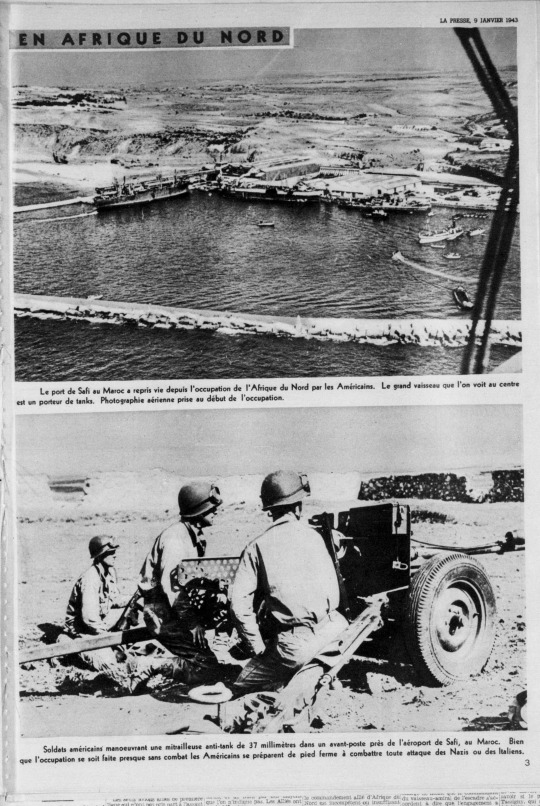
"AVEC LES ALLIES," La Presse. January 9, 1943. Page 2 & 3. ---- En haut, sous-marin français arrivant en rade d'Alger après avoir réussi à quitter Toulon peu avant le sabotage de la flotte française. Les marins seluent joyeusement. En bas, traces des dégâts causé par un raid nazi à Alger après l'occupation de la ville par les Américains.
EN AFRIQUE DU NORD Le port de Safi au Maroc a repris vie depuis l'occupation de l'Afrique du Nord par les Américains. Le grand vaisseau que l'on voit au centre est un porteur de tanks. Photographie aérienne prise au début de l'occupation.
Soldats américains manoeuvrant une mitrailleuse anti-tank de 37 millimètres dans un avant-poste près de l'aéroport de Safi, au Maroc. Bien que l'occupation se soit faite presque sans combat les Américains se préparent de pied ferme à combattre toute attaque des Nazis ou des Italiens.
#world war ii#operation torch#north african campaign#french north africa#forces navales françaises libres#toulon#algiers#safi#morocco#algeria#french colonial empire#united states army#anti-tank gun#aerial bombardment#submariners#sous-marin#flotte française
0 notes
Text

104-gun 1st rate ship of the line HMS Impregnable in the Hamoaze estuary in circa 1861
HMS Impregnable was launched on 1 August 1810 in Chatham Dockyard in Kent. The most serious action she engaged in was the Bombardment of Algiers in 1816 in which she took between 250 and 300 shots severely damaging her and causing significant casualties to her crew.
In 1862 she was converted to a training ship stationed in Devonport. Renamed HMS Kent in 1888 used as a hulk then renamed once again HMS Caledonia in 1891 to serve as a school ship at Queensferry in the Firth of Forth until sold for breaking up in 1906.
Source
115 notes
·
View notes
Text
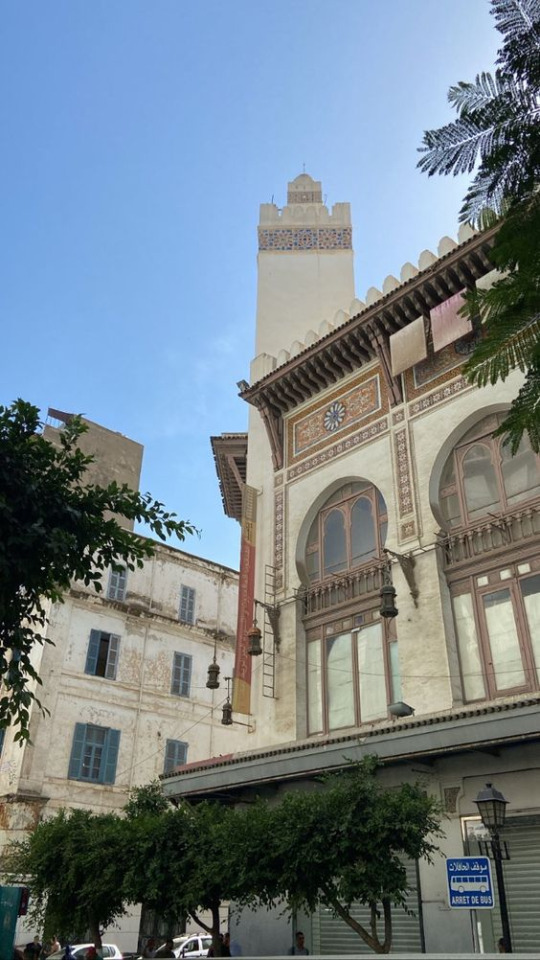

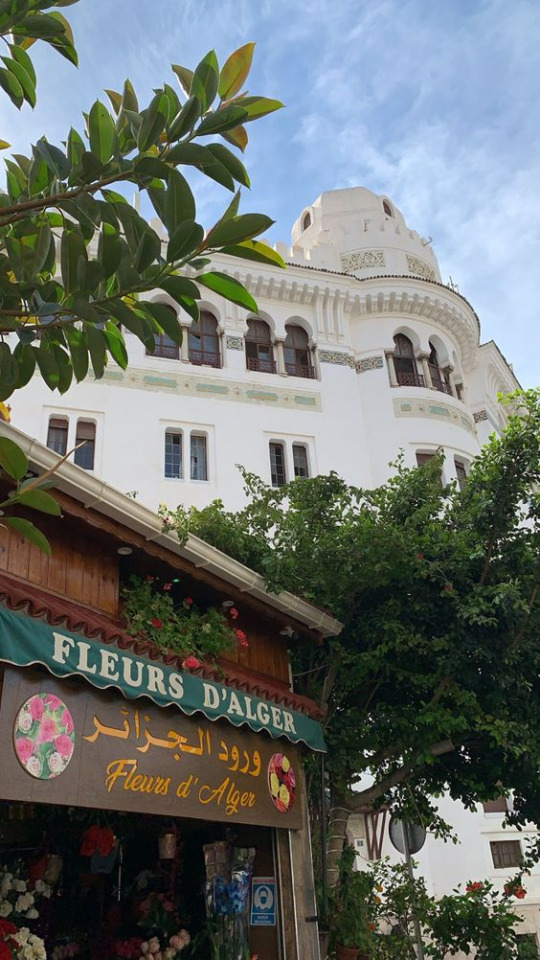
after pleading and much excitement on kylians’ end, you finally bite the bullet and take him with you to your hometown of algiers.
kylian x algerian!reader
word count : 1.3K+
watch it: fluffy fluff fluff, mild over thinking and angst if u rly rly dig deep for it
luv my country fr fr
—--
theres a small dent on the wall from where you banged your elbow so hard you swore you broke it. you were around 10. it's been years, and the little spot still stands. you never forget to run your thumb over the ridges, the cool wall warming under your touch.
It's been years, but the wall holds the memory, a mirror of you. each flick of your thumb ignites the scene inside your head over and over, you swear you can feel your elbow sting. you remember the way you hissed sharply and called for your mom, who came scuring from the hallway. and how your cousins all lined up to see the damage and soon teased you for being a baby. screeching at the 'crater' you left in the wall. your aunt snapped a picture of the comotion while she laughed hysterically, hand on her hip, head tossed back while the rest of the family filled in to check out the commotion.
you were given a wet towel to keep in your elbow till the swelling went down. and the teasing never stopped, in fact you're bound to have it happen at any second. your cousins called you bulldozer for years, some still do. that's even your contact name in a few of their phones.
it's so silly how such a little moment from so many years ago carries on. wasn't even your funniest moment in full honesty. you have much better ones.
it's been years, and it remains one of your many contributions to your grandmother's little flat. cozy and quaint in the center of algiers. today you bring a new addition, kylian.
you joked about taking him once, just a passing comment while you showed him pictures from your last trip. he hummed, latching onto the idea like an excited puppy to a chew toy. bothering you with itineraries (as if you need one in your hometown?), your texts are a wall of flight screen shots at this point. and of course bombarding you with questions every second he got the chance.
"should i pack light?"
"what cities will you take me to?"
"do you think i'll need to bring a lot of security?"
in truth, you were hesitant to bring him along.
going back home is a feeling you can never get enough of. from the moment you step off the airplane and the familiar smell of your country hits your face, to your first dip into the mediterranean, a homemade meal, singing out of cars in the dead of night while you race through the city.
bringing him is an intimate ordeal. your country is your first love, first home. she raised you in a sense.
she is a part of him, the same as she is of you. but having him in your grandmother's home? introducing him to your very lively extended family? you don't know about that.
you were worried about your sanity as much as his. you know the questions will be never ending. he's your fiance now after all, wedding in the works. this is only going to add to the disaster that is wedding planning. you know you're going to have to squeeze in promises of inviting your 2nd cousins aunts cats neighbors gardener.
and how could you forget, he's kylian. kylian mbappe. there's no way you're bringing him to the heart of algiers and going to be free to roam the streets as you please.
you know you'll never be able to do so on your own again once the media puts two and two together. good by freedom. it's easy in resorts or fancy hotels. everything can be arranged. but not here.
you and kylian value your privacy dearly. french media has barely ever gotten a proper look at your face and you intend to keep it that way. but you don't think you can get away with that here. you want to show him real places that hold history and the people. not just fancy villas on the coast that cost more than you want to think about.
he pleaded with you anyway, even after you voiced your concerns. "i have an agent and security for a reason. just take me and the rest will come easy. don't even worry."
you frowned, "it'll be in the summer, when everyone else and their mother is going."
"i just want to see it you know, authentically. i want to experience just a part of what you did growing up." he confessed, shy.
and so you caved. and here he is. leaning against that same wall you rammed into all those years ago, fanning his face with a pile of notebook paper he found lying around after a long day of unpacking the gifts you bought for your family.
he's had a long day of posing for pictures and videos, all of which you rolled your eyes at. it's nearing sunset, and you press your forehead against the familiar cool wall of one of the living rooms. it's going to be where you sleep for the next 2 weeks or so.
the couches convert to beds and you get to play the age-old game of war with the mosquitoes that torment you. you haven't told kylian yet. he needs to be ambushed in the middle of the night for the full authentic experience. ha ha ha.
you look back to where kylian is sat on the couch perpendicular to yours, hes given up on the fanning. hand under his thighs while he watches what he can of the balcony. you can see the sea from here. in all its beauty. the gentle wind it brings flutters the curtains while you hum.
tomorrow he meets the rest of your family and you can't help the butterflies that pool in your stomach at the thought. your fiance, meeting the rest of what makes this house a home. you can't wait. for now though, all you want to do is nap.
you get up from your couch, sliding on your socks to press up against his side. even if its pushing near broiling temperatures. he doesn't complain, only bringing his hands to cup your face gently, giving your nose a peck.
"its so beautiful here, " he sighs, "thank you for bringing me."
you hum into his lips, giving them a firm kiss, "you're welcome my love. i'll show you around tomorrow. it's time for my post flight nap."
he gives you a lazy smile, "yes please i was waiting for you to bring it up. it's past my nap time." he pouts.
you roll your eyes and throw one of the couches throw pillows against his chest. he manages to grab it, hurling it back at you. and while you're distracted he curls his hands against your side, tickling you till you yelp and thrash in his hold, back pressed against the couch while you gasp in between laughter.
he finally lets you go and collapses on top of you, kissing any skin he can reach.
"okay get off, it's too hot for that." you groan.
he at least listens to that, peeling himself off you and retreating to the far end of the couch while you set up yours for what you know is going to be top 5 naps of your life, easy.
against the gentle breeze and city sounds, you're lulled to sleep. in your vision you see kylian getting ready to do the same, reaching over to press one sound kiss on your forehead before settling down into his little bubble.
you could do this forever you think. you're glad he came.
#kylian mbappe fanfic#kylian mbappe one shot#kylian mbappe x reader#kylian mbappe imagines#kylian mbappe imagine#mbappe#kylian mbappe#kylian mbappe x you#mbappe x reader#kylian x you#kylian x reader#kylian imagines#kylian fanfic#mbappe imagine#mbappe fanfic#mbappé#football fanfic#kylian fluff#bahr footy
169 notes
·
View notes
Text
Events 1.24 (after 1940)
1942 – World War II: The Allies bombard Bangkok, leading Thailand, then under Japanese control, to declare war against the United States and United Kingdom. 1943 – World War II: Franklin D. Roosevelt and Winston Churchill conclude a conference in Casablanca. 1946 – The United Nations General Assembly passes its first resolution to establish the United Nations Atomic Energy Commission. 1960 – Algerian War: Some units of European volunteers in Algiers stage an insurrection known as the "barricades week", during which they seize government buildings and clash with local police. 1961 – Goldsboro B-52 crash: A bomber carrying two H-bombs breaks up in mid-air over North Carolina. The uranium core of one weapon remains lost. 1966 – Air India Flight 101 crashes into Mont Blanc. 1968 – Vietnam War: The 1st Australian Task Force launches Operation Coburg against the North Vietnamese Army and Viet Cong during wider fighting around Long Bình and Biên Hòa. 1972 – Japanese Sgt. Shoichi Yokoi is found hiding in a Guam jungle, where he had been since the end of World War II. 1977 – The Atocha massacre occurs in Madrid during the Spanish transition to democracy. 1978 – Soviet satellite Kosmos 954, with a nuclear reactor on board, burns up in Earth's atmosphere, scattering radioactive debris over Canada's Northwest Territories. Only 1% is recovered. 1984 – Apple Computer places the Macintosh personal computer on sale in the United States. 1986 – The Voyager 2 space probe makes its closest approach to Uranus. 1987 – About 20,000 protestors march in a civil rights demonstration in Forsyth County, Georgia, United States. 1989 – Notorious serial killer Ted Bundy, with over 30 known victims, is executed by the electric chair at the Florida State Prison. 1990 – Japan launches Hiten, the country's first lunar probe, the first robotic lunar probe since the Soviet Union's Luna 24 in 1976, and the first lunar probe launched by a country other than Soviet Union or the United States. 2003 – The United States Department of Homeland Security officially begins operation. 2009 – Cyclone Klaus makes landfall near Bordeaux, France, causing 26 deaths as well as extensive disruptions to public transport and power supplies. 2011 – At least 35 are killed and 180 injured in a bombing at Moscow's Domodedovo Airport. 2018 – Former doctor Larry Nassar is sentenced up to 175 years in prison after being found guilty of using his position to sexually abuse female gymnasts.
0 notes
Text
Interview with Kristi Jones
Murder In the Ranks
Dottie Lincoln Book 1
Kristi Jones
Crooked Lane Books
Nov 19th, 2024
Murder In the Ranks by Kristi Jones is her debut mystery filled with spies, murder, and a touch of romance. It is also a historical novel that delves into the American Women’s Army Auxiliary Corps (WAAC) where women served in a combat zone in Algiers. Their duties were of the administrative nature, mainly typists, drivers, translators, and switchboard operators freeing up more men to fight. The Women's Army Auxiliary Corps was renamed from WAACs to WACs, without “auxiliary” in the name.
The plot features Dottie Lincoln, who decided to join the WAAC after her abusive German husband left her for dead and took their daughter with him behind enemy lines when he joined the Nazis. Dottie Lincoln learned that it’s better to be a trained soldier rather than a victim.
Risking her own reputation, as a WAAC squad leader in World War II she becomes an investigator when one of the women in her unit is found dead. WAAC Ruth Wentz is found sprawled on the pavement in a pool of her own blood. Army officers speculate the incident was a suicide, but Dottie believes Ruth was murdered. She convinces MP Captain Devlin to look at the evidence and investigate. Secrets, deception, black market, bribery and blackmail all prevail as the investigation proceeds including Dottie’s past that comes to haunt her.
This mystery has multiple suspects with lots of twists, keeping readers guessing to the very end. Those reading this debut novel will welcome more books in this series.
Elise Cooper: Idea for the story?
Kristi Jones: I have always been interested in history and grew up as a military brat. I read Eisenhower’s Crusade in Europe where he mentioned a consignment of WACs assigned to his headquarters. I contacted the US Army Women’s Museum that had a lot of information about the 149th Post Headquarters. I did research in their archives in Virginia. I wanted to write a story about these women. I wrote my first murder mystery using these women as inspiration. Also, I was in Turkey for several years when my dad was stationed there. This helped me to write the setting of Algiers where the first women WACs were stationed.
EC: What was true?
KJ: The murder was pure fiction. But when the WACs arrived there, they were posted all over different sections. They were assigned to military police, they did office work, became drivers, and worked in signal communication. As in the book, there were officers that pushed back in having the women work in their offices, as well as officers inviting and helpful. The male soldiers in the book as in real-life reacted towards the WACs. Some saw them as dates and moral boosters. Some became jealous when the WAC women fraternized with the male British officers. Some saw the WACs as not lady-like. The women had to overcome this challenge of how the men responded to them.
EC: Do you think they broke the “glass ceiling”?
KJ: These women were pioneers, the first women stationed in a combat situation. They were considered a “test-tube company” because people wondered if they could withstand the rigors of being in a combat theatre, including under bombardment. As the war progressed, they proved themselves to do the job.
EC: How would you describe Dottie?
KJ: She is sometimes embarrassed. She speaks French and German so she can be useful to the allied cause. Dottie is protective, gutsy, and was abused. Her husband saw her as weak and vulnerable, beat and abandoned her. Her backstory is that her husband went to fight for the Nazis and took their daughter, Sophie. Throughout the series there will be the theme of a mouse to lion, where she must find her strength. She represents those real women who joined the WACs to find independence and to become a force to reckon with.
EC: What is the role of her daughter and her husband?
KJ: They were why she initially joined the military. Dottie struggles to believe in herself and needs to find her emotional and physical strength. In future books she wants to win the war to find her daughter.
EC: How would you describe Captain Devlin?
KJ: He is cocky with cop-like instincts and can be calm, caring.
EC: What about the other women WACs?
KJ: I wanted to give them each a different personality. Each of the characters were based on differences of women I researched.
Sue is calculating, sly, argumentative, troublesome, and likes to play games. There were WACs that did steal for the black-market. She is a scandal girl.
Ruth is the consummate solider, determined, serious, dependable, rational, and grounded.
Jeannie is scared, trusting, and sweet. Dottie does trust her.
Mary is the youngest, dramatic, selfish, childish, and acts princess-like. She is young and looking for adventure.
EC: What did you want readers to get out of the book?
KJ: This book quote, summarizes my feelings, “I hope Dottie’s story will illuminate their sacrifices, courage, and the critical role played in the combat theatres during World War II.” Plus, to inform people who did not know how severe the manpower shortage was in the services at that time. Recruiting these women would fill the non-combat roles to free the men to fight in combat.
EC: Next book?
KJ: Jeannie will be back and becomes Dottie’s side-kick character. It is tentatively titled A Map to Murder. After working with Military Police to solve the murder of her fellow soldier, in this book, Auxiliary Dottie Lincoln wanted to get a permanent assignment with Captain Devlin and the MPs. Instead, she is sent to work for Force 141, a top-secret planning headquarters just outside the city. She soon finds herself drawn into a web of secrecy, betrayals and murder, racing to root out a traitor before an innocent woman is hanged for a crime she did not commit.
THANK YOU!!
0 notes
Note
While this might seem a tad obscure, in the debate on Beethoven versus Rossini found in Gravity's Rainbow, where do you stand? Given that you're a self-professed layperson in music—and not to mention your surname—you may prefer the rhapsodic and spirited Rossini. Nonetheless, if any one artist in history embodied the elusive concept of genius—an ideal you champion—it was Beethoven. It seems that Pynchon favored "Signor Crescendo"; and yet, I think, this is one of the dialectical troubles of GR: he set out to compose a broken overture for the ineluctable emancipatory symphony of the preterite but in a swollen register of the late string quartets—and fell short. All the grand elusive madness but little of the compression and sublimity.
I had to look up the passage to refresh my memory. Luckily, someone's quoted the whole thing on a blog—here's the main part:
Gustav is a composer. For months he has been carrying on a raging debate with Säure over who is better, Beethoven or Rossini. Säure is for Rossini. “I’m not so much for Beethoven qua Beethoven,” Gustav argues, “but as he represents the German dialectic, the incorporation of more and more notes into the scale, culminating with dodecaphonic democracy, where all notes get an equal hearing. Beethoven was one of the architects of musical freedom — he submitted to the demands of history, despite his deafness. While Rossini was retiring at the age of 36, womanizing and getting fat, Beethoven was living a life filled with tragedy and grandeur.”
“So?” is Säure's customary answer to that one. “Which would you rather do? The point is,” cutting off Gustav's usually indignant scream, “a person feels good listening to Rossini. All you feel like listening to Beethoven is going out and invading Poland. Ode to Joy indeed. The man didn't even have a sense of humor. I tell you,” shaking his skinny old fist, “there is more of the Sublime in the snare-drum part to La Gazza Ladra than in the whole Ninth Symphony. With Rossini, the whole point is that lovers always get together, isolation is overcome, and like it or not that is the one great centripetal movement of the World. Through the machineries of greed, pettiness, and the abuse of power, love occurs. All the shit is transmuted to gold. The walls are breached, the balconies are scaled — listen!” It was a night in early May, and the final bombardment of Berlin was in progress. Säure had to shout his head off. “The Italian girl is in Algiers, the Barber's in the crockery, the magpie's stealing everything in sight! The World is rushing together….”
One wants to reject the premise of the question rather than answering it (I direct this at Pynchon, not at you). Or rather, to refuse in advance the terms by which one will be impugned for giving the obvious answer, which is Beethoven, because Pynchon—writing at exactly the same time and from some of the same motives as the postmodern theorists—frames the question precisely to associate 19th-century Romantic genius with 20th-century fascist totalitarianism, even though (as you observe) his monstrous book is unthinkable except as such a genius's prerogative—and as if the countervailing Enlightenment forces Rossini supposedly stands for in this passage didn't have troubling associations of their own, as signaled in the slightly menacing phrase "one great centripetal movement of the World." (Pynchon knows this, obviously. I wonder if he's not parodying the Settembrini/Naphta debates here.) Rossini's structural formulae, I just read in no more august a source than Wikipedia, have been likened to the Code Napoléon, just as Rossini's and Napoleon's biographer, Stendhal, admired the Corsican and would himself read the Civil Code in the morning to "acquire the correct tone" to write the operatic Charterhouse of Parma—all of which is charming back in the 19th century, but in the 20th, it looks about as much like Stalin as Beethoven looks like Hitler. I resort to cultural criticism because I've only listened to whatever Rossini they used to play over Velveeta commercials or Bugs Bunny cartoons or whatever when I was a kid—if I actually knew anything about this subject, I would insert here whatever Adornian thesis about how Ludwig's proto-modernist late quartets don't make themselves available for such fetishism or reification—but I believe my overall point still stands.
0 notes
Text

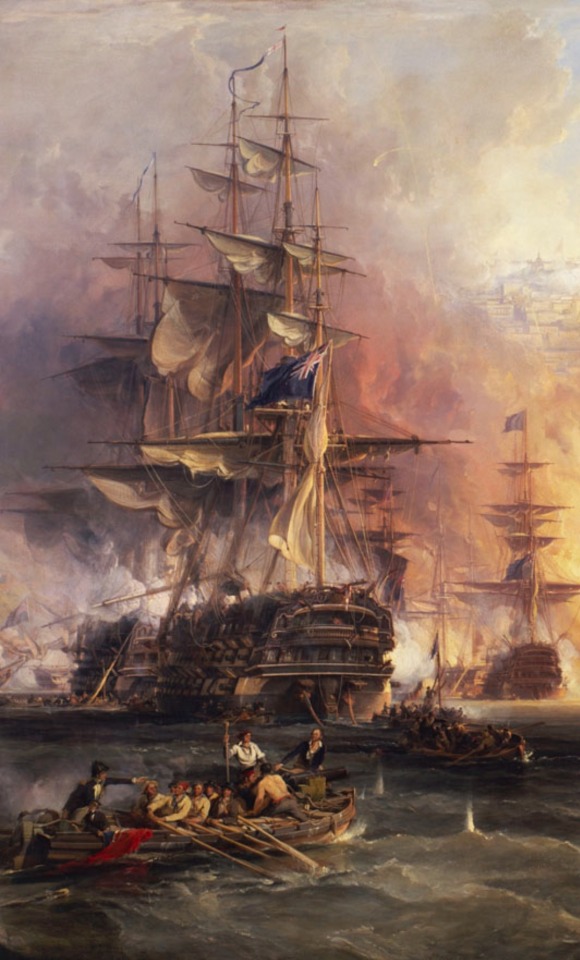
The Bombardment of Algiers, 27 August 1816 (details), by George Chambers, 1836.
#age of sail#naval battle#bombardment of algiers#george chambers#royal navy#royal dutch navy#age of fighting sail#naval history#art#the sea
54 notes
·
View notes
Photo

The Bombardment of Algiers, 27 August 1816 - George Chambers
8 notes
·
View notes
Text
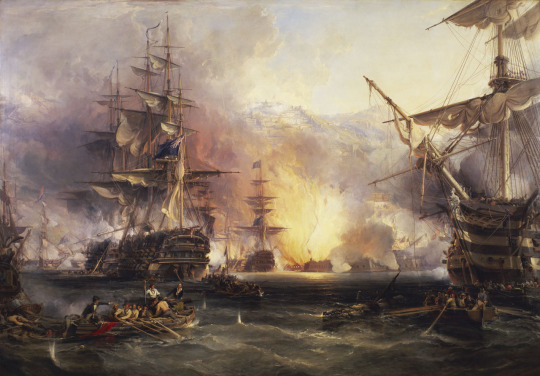

The Bombardment of Algiers, 27 August 1816
by George Chambers
#the bombardment of algiers#1816#algiers#art#painting#history#george chambers#britain#united kingdom#netherlands#holland#england#europe#european#royal navy#royal dutch navy#omar agha#deylik of algiers#dey of algiers#anglo dutch fleet#edward pellew#frederick capellen#mediterranean#barbary coast#barbary states#mediterranean sea#gibraltar#piracy#pirates#slavery
21 notes
·
View notes
Photo
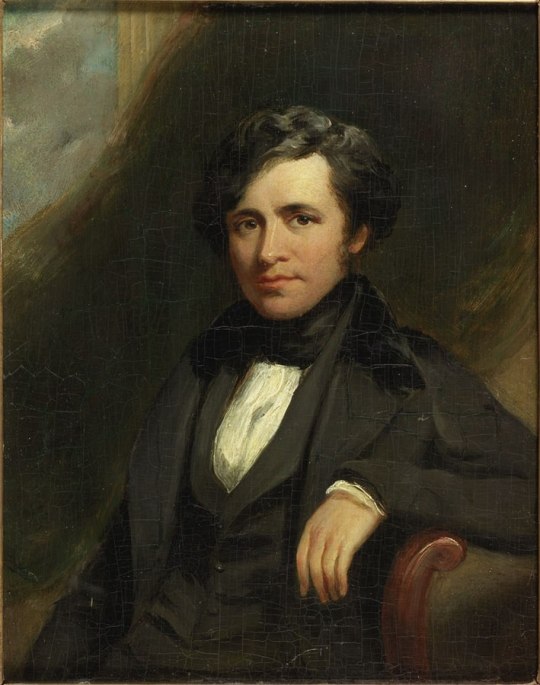
Thomas Ellerby - Portrait of John Wilson Carmichael - 1839
oil on panel, height: 25.7 cm (10.1 in); width: 20.2 cm (7.9 in)
South Shields Museum & Art Gallery, UK
Thomas Ellerby (10 January 1797 - 4 April 1861) was an English portrait artist whose work included 72 paintings chosen for hanging at The Royal Academy of Arts exhibitions from 1821 until 1857. He remained active as a painter until the end of his life.
James John Wilson Carmichael (9 June 1800 – 1868), also known as John Carmichael was a British marine painter.
Carmichael was born at the Ouseburn, in Newcastle upon Tyne, Northumberland, on 9 June 1800, the son of William Carmichael, a ship's carpenter. He went to sea at an early age, and spent three years on board a vessel sailing between ports in Spain and Portugal. On his return, he was apprenticed to a shipbuilding firm. After completing his apprenticeship, he devoted all his spare time to art, and eventually gave up the carpentry business, setting himself up as a drawing-master and miniature painter. His first historical painting to attract public notice was the Fight Between the Shannon and Chesapeake, which sold for 13 guineas (£13.65). He then painted The Bombardment of Algiers for Trinity House, Newcastle, for which he received 40 guineas; it is still at Trinity House, along with The Heroic Exploits of Admiral Lord Collingwood in HMS "Excellent" at the Battle of Cape St. Vincent, painted in collaboration with George Balmer. Another important early commission was for a View of Newcastle for which the city corporation paid him 100 guineas. During the redevelopment of the centre of Newcastle, Carmichael worked with the architect John Dobson to produce some joint works, including paintings with designs for the Central Station and the Grainger Market.[4] He also collaborated with John Blackmore to produce an illustrated book: Views on the Newcastle and Carlisle Railway in 1836.
His name first appears as an exhibitor in 1838, when he contributed an oil painting, Shipping in the Bay of Naples, to the Society of British Artists. He showed both oil paintings and watercolours at the Royal Academy, his contributions including The Conqueror towing the Africa off the Shoals of Trafalgar (1841) and The Arrival of the Royal Squadron (1843).
He lived in Newcastle until about 1845, when he moved to London, where he was already known as a skilful marine painter. In 1855, during the Crimean War he was sent to the Baltic to make drawings for The Illustrated London News. His painting of the bombardment of Sveaborg, which he witnessed during this assignment, was exhibited at the Royal Academy and is now in the collection of the National Maritime Museum.
He later moved to Scarborough, where he died in 1868.
He published The Art of Marine Painting in Water-Colours in 1859, and The Art of Marine Painting in Oil-Colours in 1864.
His daughter Annie married William Luson Thomas son of a shipbroker and a successful artist who, exasperated by the treatment of artists by the Illustrated London News, founded in 1869 The Graphic newspaper which had immense influence within the art world.
12 notes
·
View notes
Text
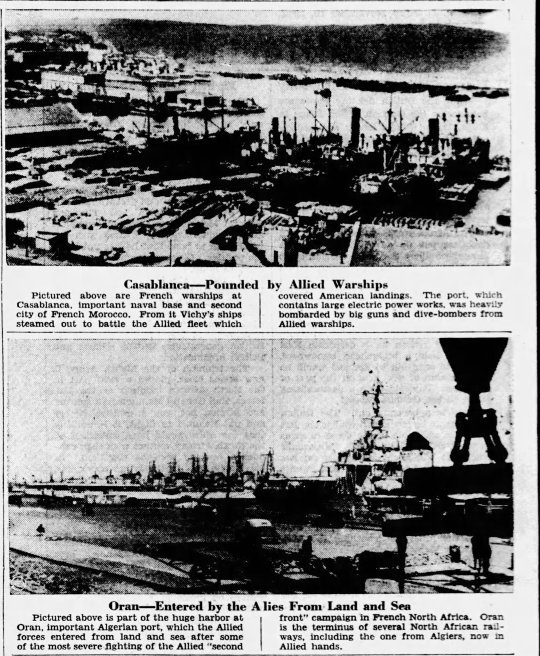
"Casablanca - Pounded by Allied Warships," Ottawa Citizen. November 10, 1942. Page 19. --- Pictured above are French warships at Casablanca, important naval base and second city of French Morocco. From it Vichy's ships steamed out to battle the Allied fleet which covered American landings. The port, which contains large electric power works, was heavily bombarded by big guns and dive-bombers from Allied warships. "Oran - Entered by the A lies From Land and Sea," Ottawa Citizen. November 10, 1942. Page 19. --- Pictured above is part of the huge harbor at Oran, important Algerian port, which the Allied forces entered from land and sea after some of the most severe fighting of the Allied "second front" campaign in French North Africa. Oran is the terminus of several North African railways, including the one from Algiers, now in Allied hands.
#naval battle of casablanca#casablanca#oran#algiers#operation torch#french north africa#régime de vichy#vichy france#allied powers#united states navy#world war ii
1 note
·
View note
Text
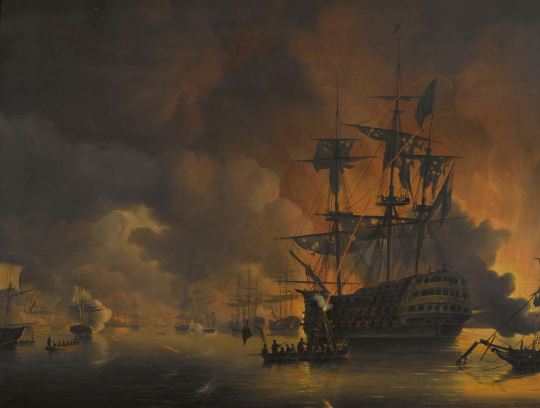
The fire on the Wharves of Algiers, shortly after the commencement of the Bombardment by the Anglo-Dutch Fleet, 27 August 1816, by Nicolaas Baur, 1816 - 1820
319 notes
·
View notes
Text

Chaplin LeGrande Moody Jr., Jacob Wannamaker, Wilbur Eidson, and Weldon James pose for a photo on the main deck of USS TEXAS (BB-35). She was on her way from Southern France for Operation Dragoon and was the Flagship of Bombardment Force Task Force 85.
Photographed near Algiers or Oran, Alergia, sometime between August 21 and September 4, 1944.
Note: other crewmen are exercising in the background.
Texas Parks and Wildlife Department: TXPWD_1996-19-32
#USS TEXAS (BB-35)#USS TEXAS#New York Class#battleship TEXAS#Dreadnought#Battleship#Warship#Ship#United States Navy#U.S. Navy#US Navy#USN#Navy#Algiers#Oran#Alergia#August#September#1944#my post
86 notes
·
View notes
Text
Animation Night 114 - Joann Sfar
So. Hello everyone! Welcome back to Animation Night.
In the misty olden days of Animation Night, back on #11, we held a night on French animation. On that day we were going to watch The Rabbi’s Cat, directed Joann Sfar. But, unfortunately, the torrent gods were not kind enough to grant me seeds, and so we didn’t get the chance.
But in the time since, it seems a seed managed to log on! So we can finally see what we missed...

Joann Sfar, then! Sfar is a French comics writer and artist, of the major figures of a ‘new wave’ of bandes desinées in the mid-2000s. He’s got quite a set of parents: his mother Lilou was an Ashkenazi-Jewish pop singer from Ukraine, and his father André Sfar a Sefardi-Jewish lawyer from Algeria who spent his career taking down neonazis.
And if that’s not enough, Lilou died when Joann was just three years old, so he was raised by André along with Lilou’s own father, a Ukrainian military doctor who during WWII was able to save the injured right hand of the novelist André Malraux, author of La Condition humaine (known in English as Man’s Fate) and thereby secure himself French citizenship. This information I’m just copying from Wikipedia, but it seems to be sourced from interviews with Sfar.
All this is relevant, because Sfar channels a lot of his life into his works. The Rabbi’s Cat in particular draws on his father’s life in Algeria, in the 1920s when Algeria was a French colony (forty years before Algeria would secure its independence).

A brief word on the background to this: by 1830, Algeria had been controlled for hundreds of years by the Ottoman empire, during which period it enjoyed more or less independence, sometimes even having wars with other Ottoman subjects. It was one of several homes of the ‘Barbary pirates’, who attacked European towns and ships primarily to take slaves.
It seems that these ‘pirates’ were continuous with the state, with the ruler’s title of Dey established by the corsair captains in 1671, and recognised by the Ottomans as regent from 1710, taxing a countryside ruled by ‘autonomous tribal states’ (a phrase due to Helen Chapan Metz, whose Algeria: A Country Study seems to have been paraphrased to make the Wikipedia article.)
Despite many Deys getting assassinated, this arrangement remained stable and lasted up into the 19th century. Gradually, though, the European powers started to win the naval wars: the Spanish leveled the city of Algiers in 1784, the US defeated the Ottoman Algerians twice in the early 1800s, and then an Anglo-Dutch fleet showed up in 1816 to bombard Algiers again. Finally, the French invaded in the 1830s, taking first Algiers and then gradually the rest of the country by 1875 and killing ‘approximately 825,000’ indigenous Algerians in the process through ‘scorched earth’ warfare and resulting disease, reducing the population by around a third.
After the end of the war, thousands of French and European settlers moved into Algeria, and the French ran a program of forced assimilation, while confiscating communal land from the ‘tribal peoples’ for the private benefit of European settlers, while suppressing the native Muslim population. Eventually, following the end of WWII, Algeria would throw off French rule after a brutal war in which they faced concentration camps, rape, torture and arbitrary, gruesome executions, a period famously written about by Frantz Fanon’s The Wretched of the Earth; all of this proved a terrible way to control a population and the Algerians fought back hard, until the French begrudgingly accepted Algerian independence in 1962. Since then, the country has mostly been ruled by the FLN, the primary nationalist party.

This story takes place roughly in the middle of French rule, during the 1920s. The premise is that a cat belonging to a Sefardi rabbi eats a parrot, gaining the ability to speak; deploring the cat’s behaviour and sarcasm, the rabbi decides he ought to teach the cat Torah, which throws open a theological can of worms.
So, more historical background! Jews in Algeria during the period of French colonisation were allowed to gain French citizenship while Muslims were not, putting them in the awkward (and perhaps all too familiar) position of go-between for colonisers and colonised and potential scapegoat. During the war for independence, the FLN appealed to Jews to side with them, but a large part of the Jewish population sided with the French instead; after the war, only three-generation Muslims were given Algerian citizenship and almost all the Jewish population of Algeria fled to France, André Sfar presumably among them. So that’s the background inflecting Joann’s life; by the time he was born in 1971, the war was over, and all of this he could only hear second hand.
The Rabbi’s Cat began life as a comic book series which ran from 2002-2006, went on hiatus, and then resumed in 2015 with near-annual releases up until 2021. I haven’t read it, but you can read a brief review of it here.

So now we come to the actual animated film, created by Sfar’s own Autochenille Production, a company founded in 2007 to make “author-driven, challenging films to appeal to children and adults” named after a car that features in The Rabbi’s Cat. It is funded by multiple French TV networks; I would not be surprised if it also had a bunch of government arts council funding like the vast majority of European animated films. It dropped at - where else? - Annecy in 2011, and duly won the award.
Of its production, most information is only available in French, but luckily the MTL is pretty good. Sfar had been bombarded with offers to adapt his comic, refusing all of them; he only thought of directing it himself when his editors asked him why. He was accompanied by two more experienced directors of animated films, Clément Oubrerie and Antoine Delesvaux, and brought in a lot of younger animators such as the ‘band of little geniuses’ Hugo Ferrandez, Grégory Elbaz, Gabriel Schemoul and Agnès Maupré with fine arts backgrounds, plus a couple of experienced animators in Jean-Christophe Dessaint and ‘Zyk’ who I believe helped with shooting video reference.
The animation process involved shooting a lot of live action reference footage with pre-voicing; their inspiration went back to early Disney (Animation Night 84) and Fleischer (briefly discussed Animation Night 21). Of Fleischer, Sfar says (google translation):
"Leurs dessins animés ne s'adressaient pas qu'aux enfants, raconte Sfar. On y voyait des histoires d'amour, des voyous, des vraies bizarreries. Le studio Fleischer était très cosmopolite, un mélange d'immigrés juifs et italiens. Toutes leurs musiques étaient faites par la crème des jazzmen noirs. Plus quelques vrais truands parmi les bailleurs de fonds."
"Their cartoons weren't just for children, says Sfar. We saw love stories, thugs, real oddities. The Fleischer studio was very cosmopolitan, a mixture of Jewish and Italian immigrants. All their music was made by the cream of black jazzmen. Plus a few real mobsters among the backers."
Visually, he had ambitions: in contrast to Persepolis, clearly a big inspiration, he wanted to do something ‘truly cinematic’ with ‘great spaces, depth of field’ inspired by Fritz Lang, Fellini and del Toro. Sfar had directed one film before this in live action, but this was his first time in animation. Not that you’d know it: a quick scan through shows the film is full of nice little subtle bits of character acting, and the backgrounds have an unusual style that takes after the comics in using flat shading, thin black lines and hatching.
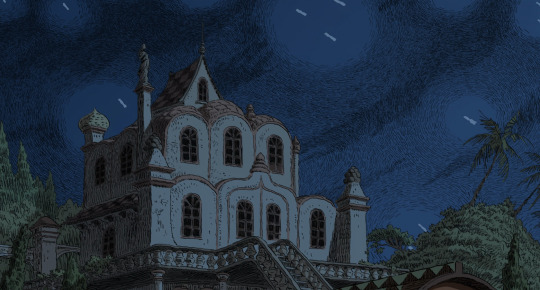
It doesn’t always quite work (scenes of perfectly static water ripples are especially odd), but it’s certainly distinctive.
Narratively, the film goes through a series of episodes, eventually turning on the Rabbi, his cat and a Soviet painter going out on an expedition into the desert intending to find a country of Jews in Ethiopia. Reviews particularly speak of the film’s illustration of kinship between Jewish and Arab people; they are sometimes critical of the plot’s meandering but generally come out to praise the film. And it comes with a friend’s recommendation as well, so I’m looking forward to it a lot.
It seems to be Sfar’s only animated film, sadly. He was a producer on Aya of Yop City, another autobiographical comic-based film directed by Ivorian author Maruerite Aboute and Clément Oubrerie; a big step up for French animation set in Africa insofar as its director is actually African (*looks sternly at Kirikou*). Unfortunately, I have not been able to track down a copy of this film.
Then, to round out our program, we have a little oddity from 2014: a package film that brings together renowned independent animators from across the world. That film is The Prophet, adapted from the 1923 book of mystic parables by the Lebanese-American poet and writer, Kahlil Gibran. The film is the passion project of actress Salma Hayek, directed by The Lion King director Roger Allers; it comprises a unifying CG story about the meeting of a young girl and a too-good-for-this-world poet, framing a series of short musical sequences based on Gibran’s poems, each one directed by a well-known independent animator in their characteristic style.
youtube
Of the list, then, one is Sfar (hence the inclusion in this night). Others include the brilliant Tomm Moore of Cartoon Saloon (Animation Night 14, Animation Night 49) and Bill Plympton who we met a few weeks ago (Animation Night 112), as well as Mohammed Saeed Harib from the UAE, creator of the FREEJ series, and Paul and Gaetan Brizzi, a pair of twins who have both worked together on French animation such as Asterix vs Caesari and Babar before joining Disney in 1990 and working there for several decades during the ‘renaissance’ period. With such a diverse and talented set of animators on board, how could it possibly go wrong?
Unfortunately, the last inclusion is... more of a problem for me. Nina Paley is an independent animator and copyleft proponent known for her two religious satire films Sita Sings the Blues and Seder-Masochism... and also an active TERF, like, and I don’t mean this in the sense of ‘said some nasty things once or twice’ but like, ‘outspoken proponent of the “gender critical” hate-cult movement’. She’s one of those people in the open source movement who just seem to think that, after making a few breaks from the social dogma, they have everything figured out, and then immediately take a massive shit on some other group of people. And it inflects her movies too; Seder-Masochism is a gender-essentialist fable all about how patriarchal authority covered up the good wholesome womens’ version of Judaism, which is hard to swallow with the TERF thing running under the surface. So as far as I’m concerned, she can fully fuck right off; I will show some films by some pretty dubious people but this one’s personal lmao; don’t expect to ever see Animation Night: Nina Paley.
On top of that, we can add the casting of Liam Neeson as the voice of the poet. To be fair, when this film came out, Neeson’s bizarre racist diatribe had yet to happen, but his voice just sounds glaringly awful in the role of ‘the poet’, the intonation of an American reading out quotes in a civ game. It sounds bad enough that I went looking for a copy of the French dub, without success. The trailer ends with him going ‘my crime? poetry.’ in a voice like we’re supposed to go oooooh, how could they and not just burst out laughing. I went looking for the French dub as more likely to be bearable, but I can only find it in English.
So the production seems like kind of a mess. What I might do is just like, fast forward the framing story and show only the guest segments, since they’re really the only reason I’m interested in this thing in the first place. Still, it is the only other piece of Sfar animation I have to hand, and I do think there is likely to be some gorgeous animation in those guest segments.
And that’s about all I have time to write. Animation Night 114 will begin at around 8pm UK time, around 4 hours from this post, at picarto.tv/canmom - until then I will be working on my Chroma Corps character, so please feel free to drop by!
7 notes
·
View notes